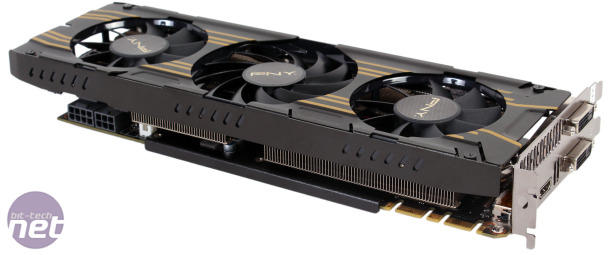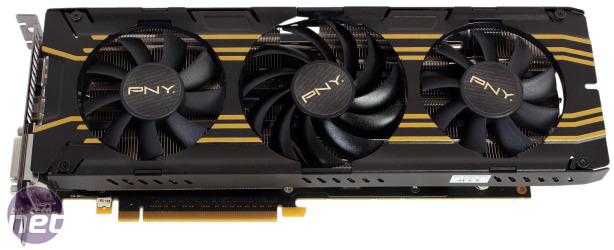Performance Analysis
In Battlefield 3 the GTX 780 XLR8 has an 8-13 percent lead on the stock speed card, but the GTX 780 Ti maintains a similar lead over it, leaving PNY's card as the midway point between the two Nvidia ones. It also surpasses the R9 290X at 2,560 x 1,600 and 5,760 x 1,080, although AMD's card gains a very slight advantage at 4K, the resolution it was designed for. Finally, the GTX 780 XLR8 is also very closely matched to GTX Titan in each test, and even nudges past it at 4K.The first thing to note about the Battlefield 4 results is that the GTX 780 XLR8 outperforms GTX Titan every time. This is only by 1fps, but still the difference is repeatable and not bad given that the latter card is almost double the price. Sadly, it's not quite able to catch the GTX 780 Ti, although it does get closer here than in Battlefield 3. The R9 290 and R9 290X continue to exert dominance in this game, however, especially at 4K.
In BioShock Infinite, PNY's card is again pretty much at the halfway point between the GTX 780 and GTX 780 Ti, but the clock speed boost over the GTX 780 again gives it its strongest lead at 4K, where's it's over 20 percent faster in terms of the minimum framerate and even a little bit faster than GTX Titan. It's also consistently faster than the R9 290X, trumping its minimum framerates by 2fps in every test.
At 2,560 x 1,600 we see a familiar pattern in Crysis 3, with the GTX 780 XLR8 again sat right between the GTX 780 and GTX 780 Ti and with a slight lead over the R9 290X although it drops below this card at the higher resolutions. This game also favours GTX Titan more than any other, so the GTX 780 XLR8 isn't able to catch it here despite its high clock speeds.
In our final games test, Skyrim, the GTX 780 does well again at 2,560 x 1,600 and 5,760 x 1,080, with the usual 7 or 8 percent lead over the GTX 780, a slightly smaller edge over the R9 290X and a lead over GTX Titan too. However, at 4K, its advantage over the GTX 780 falls to just 1fps, while the GTX 780 Ti and R9 290X take more convincing leads.
The Unigine Valley benchmark does favour Nvidia hardware, but the score is still impressive. Compared to the GTX 780, its score of 2,529 is 10 percent higher, while it's only beaten by GTX Titan and GTX 780 Ti by 2 and 5 percent respectively. Its score also puts it pretty much on par with the HD 7990, a dual GPU card, while giving it a clear lead over all of AMD's single GPU cards as well.
PNY's overclock does increase the GTX 780 XLR8's power consumption to almost 50W more than the standard GTX 780. Even so, it's still some way behind the R9 290 and R9 290X in this regard, which is great considering how frequently it outperforms them.
The triple fan cooler does great work keeping things cool, as the delta T is 17°C below what the stock card manages, which is even more impressive considering the 17 percent overclock that PNY's card has. It's also quieter than the stock cooler, although the fans do still kick up a hum under load, typically reaching speeds of 53 percent. That said, given how low the temperatures are, there's plenty of leeway for you to limit the fans to slower, quieter speeds while still ensuring that everything runs smoothly.
It's a real shame, therefore, that we heard some whining from the power circuitry when the card was under load, as this is something users can do little to alter. It's not a loud noise, but it's at an annoying pitch, so bear this in mind if you have your system at desk level or otherwise have a very quiet system, as this will make it more apparent and harder to ignore.

MSI MPG Velox 100R Chassis Review
October 14 2021 | 15:04











Want to comment? Please log in.